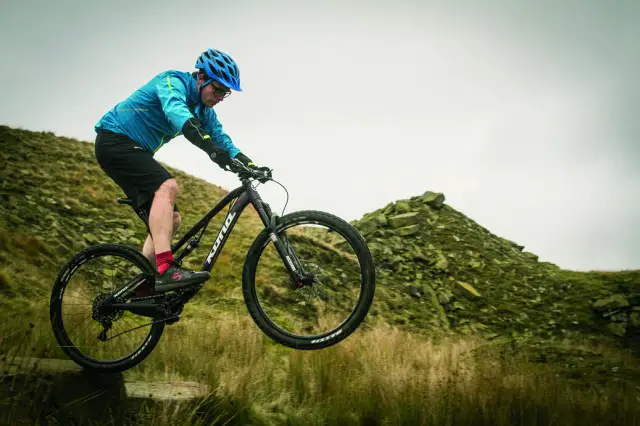The Process range from Kona has been making substantial waves among aggressive riders for a while. The Process 111 is the epitome of the short travel gnarly bike: an extremely short, single pivot 430mm rear end is mated, via a beefy-looking multiple rocker driven linkage (and a RockShox Monarch RT), to the stereotypical ‘long and low’ front end.
https://vimeo.com/111095721
Actually very low – our XL test bike had a seat tube which measured 18.3in centre to top on a bike with a 24.4in stack; and very long – the estimated top tube measures just over 26in. So there is plenty of room to move about in there, even with the short 40mm stem. Wheels are suitably stout WTB rims mated to Novatec hubs. These are shod with Maxxis Ardents front and rear.
Drivetrain-wise, the lack of space (or need) for a front mech means we get a 1×11 SRAM X1S groupset and a press-fit bottom bracket. I’m always slightly suspicious of press-fit bottom brackets – they seem to be a compromise based on cost rather than performance – but it performed flawlessly for the duration of the test. Brakes are Shimano SLX: the front has a 180mm rotor and the rear a 160mm. On a bike of this size we’d have liked to see a 203mm rotor up front and a 180mm on the back.
And finally, the Process 111 comes with a wide-ish 760mm bar, and a KS LEV internal dropper post which has a WTB saddle bolted onto the top.
Trail Notes.
The first thing to mention is the size. This is the XL, but even so it’s enormously roomy. For our taller testers this was a fabulously comfortable bike to ride when out of the saddle. The problem came with the very short seat tube. Normally on a bike of this size, you’d expect a seat-tube of at least 20in centre to top. But the 18.3in tube, coupled with the comparatively short KS seatpost, meant that our tallest tester at 6ft 4in found it impossible to get the saddle high enough to climb comfortably for any distance. It’s not a complete deal-breaker, however – the problem could be remedied with a slightly longer post (a RockShox Reverb, for example) which would have been enough to sort the problem out. But if you’re very tall, do try before you buy, and be prepared to negotiate with your LBS to swap the seatpost out.
If you’re not preposterously lanky, though, the bike climbed perfectly acceptably, although you do need to get your weight quite over the front to counteract those short chainstays and the long front end. There was a little heel-rub on those very beefy stays for some testers, too, which might be an issue if you ride heels-in. The flipside of that, though, is the fabulously stiff and punchy rear end. So crank up to the top, drop the post, and let ’er rip…
On the descents, this bike is an absolute monster. It sports very similar head and seat angles to the Orange, and the bottom bracket even sits a smidge higher, but the long top tube and short stays change your relative position on the bike and massively alter how it feels. Initially, as your relative weight is further back than it would be on a less progressive bike, it was a struggle to manoeuvre, but as we got used to the angles, played with fork and shock pressures and learned where to place and lean, it really came alive. 120mm of travel doesn’t quite let you blunder through everything without thought, but it lets you get away with some pretty inadvisable line choices; you actually do still need to make those line choices, however. The back end was so tucked in that skurfing it around corners was a doddle, and a quick lift of the heel could place and plant the back end with ease. Similarly, air-time was something that this bike absolutely welcomed once we were used to the weight distribution – and the build is burly enough to cope with less than smooth landings admirably.
So this is probably the most gnarly bike on test – if you’re prepared to ride it hard, it will reward you in spades. It climbs acceptably – provided you fit it – but you’ve got to interact with it on the downs to get the best out of it: don’t expect to just sit there and let it carry you unless you like being pinged from pillar to post. But make no mistake, this is a fabulous bike, and the efforts you have to put in can only make you a better rider.
- Frame // Kona 6061 butted aluminium
- Fork // RockShox Pike RC 120mm
- Shock // RockShox Monarch RT 111mm
- Hubs // Novatec
- Rims // WTB ST i23 TCS
- Tyres // Maxxis Ardent 2.4 front, Maxxis Ardent 2.25 rear 29in
- Chainset // SRAM X1 1000
- Front Mech // N/A
- Rear Mech // SRAM X1S
- Shifters // SRAM X1S
- Brakes // Shimano SLX
- Stem // Kona 40mm
- Bars // Kona XC/BC 760mm riser
- Grips // Kona S-LOG
- Seatpost // KS LEV Integra
- Saddle // WTB Volt Sport SE
- Size tested // XL
- Sizes available // S, M, L, XL
- Weight // 30.9lbs without pedals
Review Info
| Brand: | Kona |
| Product: | Process 111 |
| From: | Kona, konaworld.com |
| Price: | £3,599.00 |
| Tested: | by Barney for Two months. |

